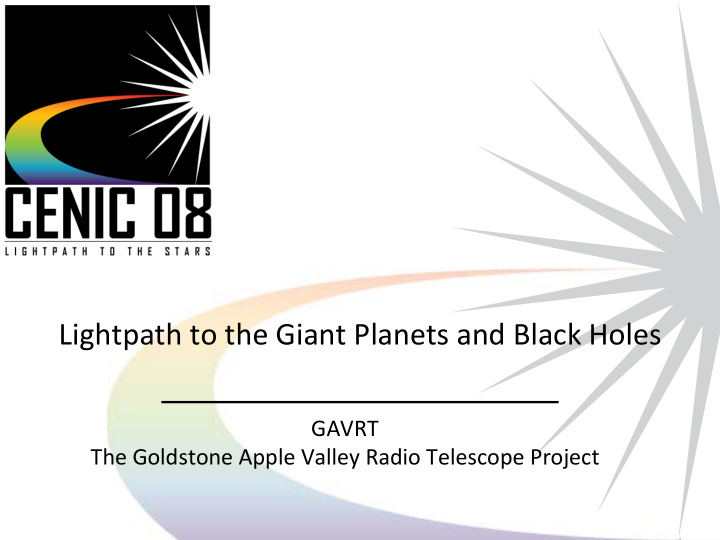



Lightpath to the Giant Planets and Black Holes GAVRT The Goldstone Apple Valley Radio Telescope Project
“Scientific discovery is possible; personal discovery is assured.” ~ Dr. Michael Klein
GAVRT PROGRAM PARTNERSHIP JET PROPULSION LABORATORY LEWIS CENTER FOR * INTERPLANETARY NETWORK & M.O.U. EDUCATIONAL RESEARCH INFORMATION SYSTEMS DIRECTORATE APPLE VALLEY, CALIFORNIA DSN * SCIENCE ACADEMY for OFFICE (902) Global Programs ACADEMIC EXCELLENCE (Charter School) GLOBAL OUTREACH LOCAL/REGIONAL OUTREACH JPL GAVRT GAVRT GAVRT TEACHERS & STUDENTS * DSN = DEEP SPACE NETWORK FOR * SPACECRAFT TELECOMMUNICATIONS M.O.U. = MEMORANDUM OF UNDERSTANDING MJK/JPR 1478 1/111/00
The Goldstone Apple Valley Radio Telescope Program (GAVRT) is: An educational program involving three partners, NASA, JPL, and the Lewis Center for Educational Research (LCER). A K-12 program enabling students to become active members of a real science team -- they study planets, galaxies, and distant quasars using radio astronomy --they connect via the Internet to the Mission Control Center at LCER --they remotely control a 34-meter radio telescope, once part of NASA’s Deep Space Network; -- they collect and analyze science data then forward it to professional scientists -- they communicate with scientists. MJK/JPR 6 ‐ 26 ‐ 02
of the 3 4 The Dish Antenna DSS 1 2 Meter
Subreflector Incoming Radio Waves Dichroic Plate X ‐ band “feed horn” S ‐ band “feed horn”
SCANNI NG THE ANTENNA BEAM ( FI ELD OF VI EW ) ACROSS A COSMI C RADI O SOURCE POWER POWER "ON SOURCE" * BACKGROUND POWER 0.100 0.050 0 .050 .100 POINTING OFFSET (DEGREES) * BACKGROUND = 3K COSMIC BACKGROUND + GALAXY + ATMOSPHERE + ANTENNA FEED SYSTEM + RECEIVER MJK ‐ 21 1496 7 ‐ 19 ‐ 99
CURRENT CURRI CULUM PROJECTS Jupiter Quest Uranus Quasar Variability Study ( QVS) Mars Radar
Juno – A Jupiter Polar Orbiter Why send a spacecraft to Jupiter? Juno will improve our understanding of the solar system by helping us understand the origin and evolution of Jupiter: Origin: Measure the water and the ice/rock core, to better understand how Jupiter formed. I nterior: Map the magnetic and gravitational fileds to understand Jupiter’s internal structure. Atmosphere: Map Jupiter’s deep atmosphere to understand the roots of the structure we see at the top of the clouds Magnetosphere: Study the radiation belts, aurorae, and the rest of Jupiter’s huge magnetosphere.
The Spitzer Space Telescope is the third of NASA’s planned Great Observatories. It was launched in 2003. GAVRT is working with Spitzer in developing a multi ‐ wavelength approach to studying the universe at infrared and radio wavelengths. Teachers wrote a proposal that was accepted for live observation using the Spitzer Space Telescope.
GAVRT QVS 2.3 GHz: 0059+581 5 4 10% Variation 3 Flux Density, Jy DSS12 DSS13 2 1 0 0 10 20 30 40 50 60 70 80 90 100 110 120 130 140 150 160 170 180 190 200 210 220 230 240 250 DOY (2005)
Lewis Center for Educational Research Lewis Center for Educational Research Apple Valley, CA Apple Valley, CA
Recommend
More recommend